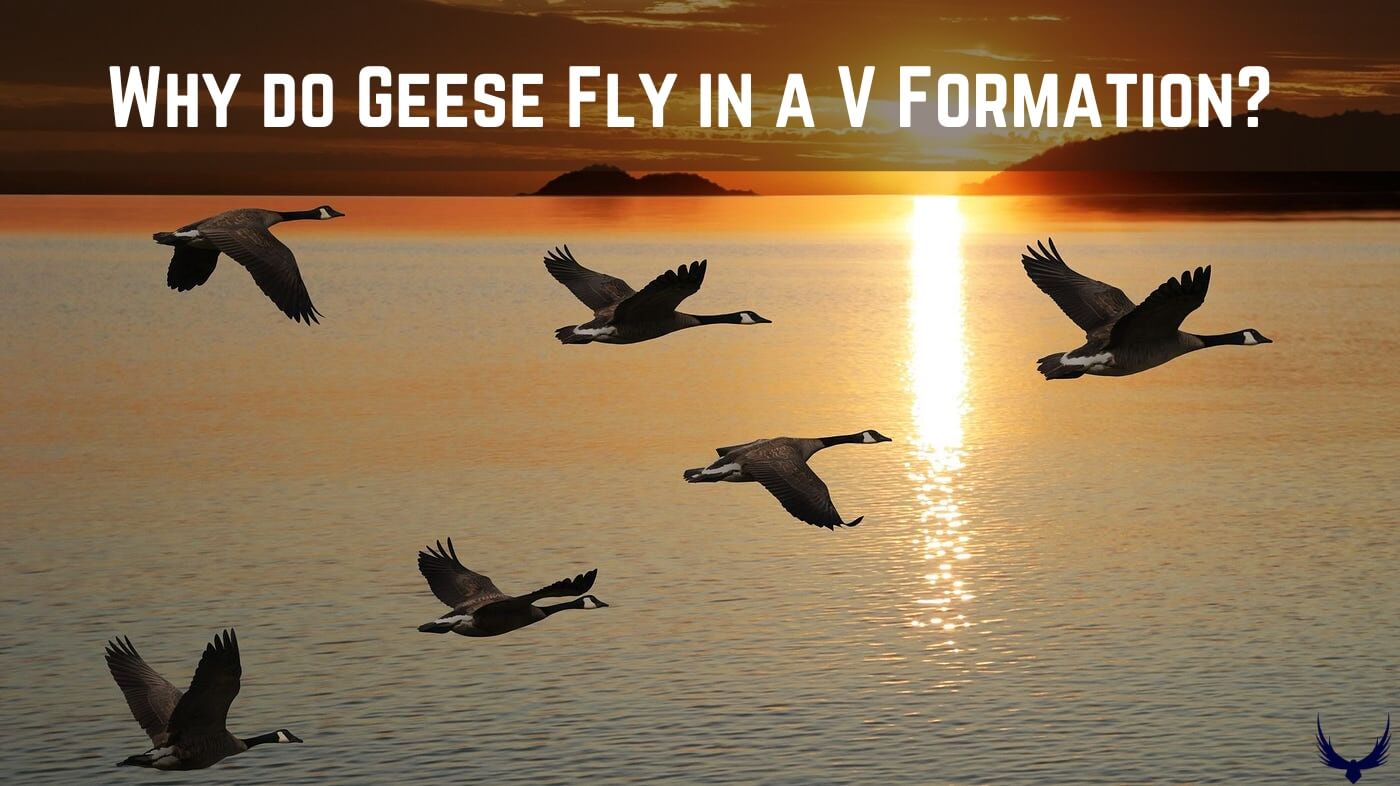Have you ever seen geese flying in a V formation? This teamwork and coordination of geese have interested scientists and bird lovers. Why do geese fly in this formation instead of alone or in a random group? The reason is their instincts, evolutionary benefits, and efficient flying skills.
Let’s explore why do geese fly in a V formation and what makes them unique among birds.
Why do Geese Fly in a V Formation?
Geese flying in V formation help them to save energy and fly farther during long trips. The V shape reduces wind resistance, allowing each bird to take advantage of upward wind currents created by the flapping wings of the bird in front. This lets them fly 25% farther without using as much energy during long trips than if each bird flew alone.
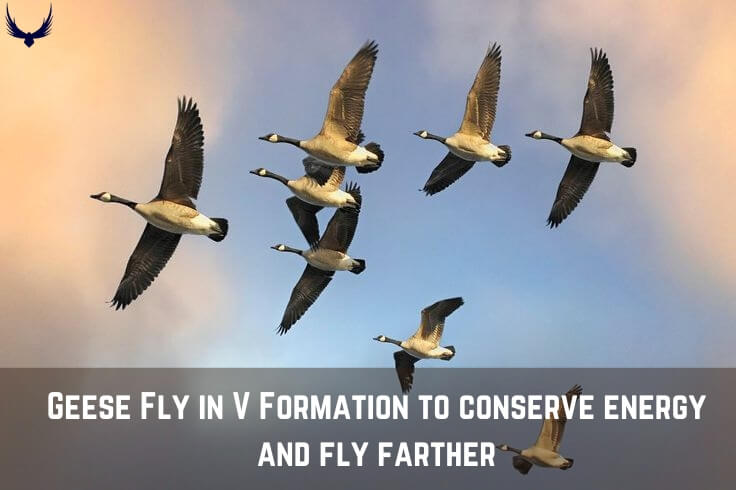
The geese V formation also helps them communicate and work together easily among the flock, with lead bird positions rotating periodically. The V shape provides maximum visibility for all birds to see their surroundings and navigate effectively.
This way of flying has evolved as the best way for migratory birds to travel long distances while saving energy.
Purpose of Geese Flying in V Formation
Geese fly in a V formation during long-distance migrations for important reasons. Here’s why they do it:
Aerodynamic Efficiency
The geese V formation pattern helps them to fly more efficiently by taking advantage of the aerodynamic principle known as “Airstream Principle“, which helps reduce wind resistance and save energy.
When each bird flaps its wings, it creates an updraft of air, helping the bird behind it fly more efficiently. This formation allows the flock to fly farther, increasing their range by at least 25%.
Energy Conservation
Long-distance migrations are extremely energy consuming, and by forming a V shape geese fly long distances using less energy. This formation helps them save energy by riding the air currents created by the bird in front.
The lead bird, facing the most wind resistance, periodically rotates with other birds in the formation to share the workload. This teamwork reduces fatigue and lets the flock travel longer distances without expending as much energy.
Visibility and Safety
Geese flying in V formation enhances visibility for the entire flock, allowing each goose to have an unobstructed view of the sky ahead, especially during long migrations. This increased visibility helps the geese to spot dangers like predators, power lines, or bad weather early on. It also helps them find good places to rest during their journey.
Easy Communication & Navigation
This Geese flying formation helps geese to maintain visual contact with each other, facilitating effective communication and coordination. The leader goose guides the flock, while the other geese can easily follow its movements and vocalizations.
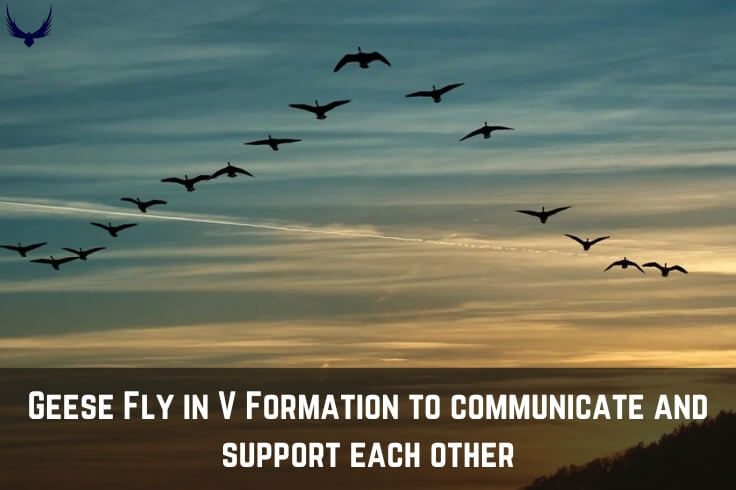
The other geese can easily maintain visual contact with both the leader goose and the geese beside them. Geese also honk or make other sounds to stay together, especially in bad weather or when encountering obstacles.
This close proximity and communication helps the flock to stay on track and find their way during the long journey.
Environmental Adaptation
The Geese V formation is an instinctive behavior that has evolved over time, helping geese adapt to their migratory lifestyle. It allows them to cover vast distances more efficiently, conserving energy and increasing their chances of survival during long journeys.
Advantages For Geese Flying in V Formation
Geese and other migratory birds use the V formation to stay in touch and improve their chances of successful long-distance flights. Flying in a V helps geese in many ways:
Geese Flying Further Together
The geese V formation allows each goose to take advantage of the updraft created by the bird in front, reducing air resistance and saving energy.
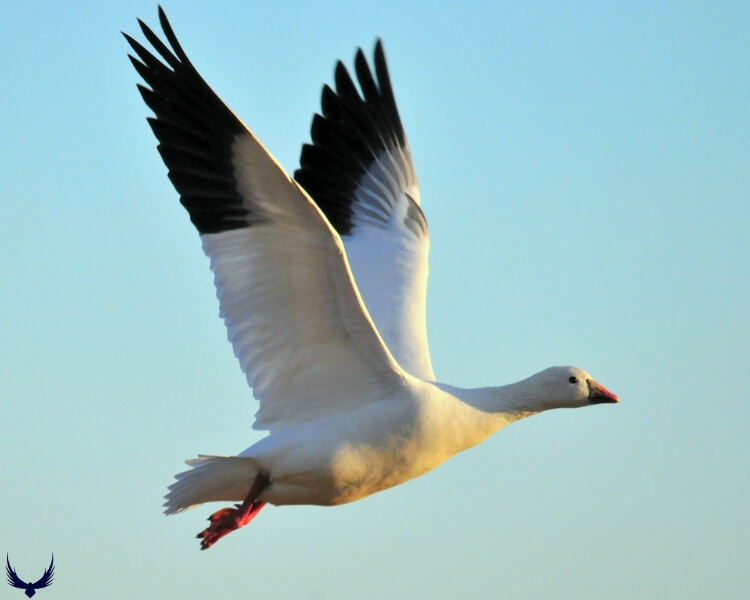
This aerodynamic benefit enables the flock to fly much further than any single bird could fly alone, symbolizing the power of cooperation and teamwork.
Geese Support Each Other When Times are Tough
When a goose gets hurt or tired and falls out of V formation or can’t keep up with the group, two other geese will stay back to help and protect it until it can fly again or catch up. This shows how important it is for a team or community to stick together and help each other out.
Geese Take Turns Leading
The lead goose experiences the most wind resistance, periodically takes turns with other goose in the formation, allowing them to share the workload and prevent exhaustion. This shows how important it is for a team to share tasks, acknowledge each other’s strengths, and avoid getting too tired.
Good teams know it’s helpful to switch leadership roles and let different members lead at different times.
Geese Cheer Progress
Geese often honk loudly to cheer on their flock’s progress. This shows the importance of celebrating team achievements within a team or group. Recognizing milestones and successes can boost morale and motivation, just like how geese honking keeps the flock inspired and helps them to continue their journey.
Geese are Loyal to their Purpose
Geese migrate annually, often traveling thousands of miles to reach their breeding or wintering grounds. They are committed to their goal despite the challenges and hardships during the journey. This dedication is like what teams and organizations need to achieve their objectives.
Protection From Predators
Geese Flying in a V formation provides better visibility and allowing them to spot potential predators more easily. The formation creates a larger, more intimidating visual presence, which can inhibit predators from attacking.
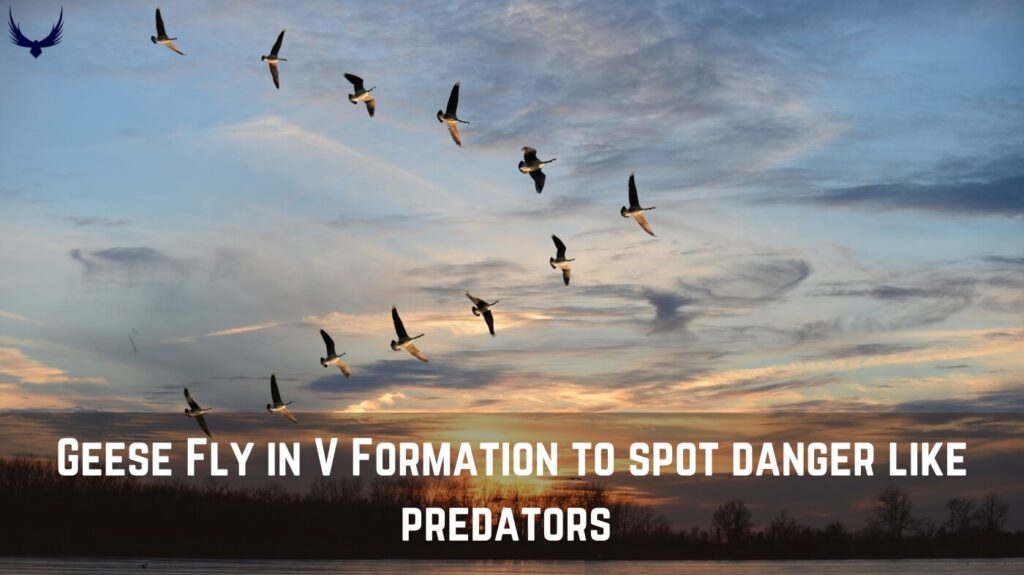
Factors Influencing Flight Patterns of Geese
Geese fly in a V-shaped formation pattern due to different factors. Here are the factors that influence how geese fly and group together during their migrations.
Wind and Weather Conditions
Geese are highly sensitive to wind and weather patterns, which can significantly influence their flight formations and migration routes. Strong headwinds make the V formation longer and more streamlined to save energy.
Tailwinds let geese fly in a looser formation because the wind helps them, since the wind helps them fly easier. Bad weather such as heavy rain or snowfall, can cause the flock to fly in a more compact formation to maintain visual contact and communication
Flock Size and Composition
The size and composition of the flock can impact the flight formation and dynamics. Larger flocks tend to adopt a more organized and streamlined V-shaped formation, while smaller groups may fly in a less organized way.
The presence of younger or inexperienced birds can also influence the formation, as they may need help from older birds in the group.
Leadership and Navigation
The lead goose in the V formation plays a crucial role in guiding the flock and deciding the flight path. This lead position is often rotated among the more experienced, older and physically fit birds in the flock, allowing them to share the workload and conserve energy.
The lead goose can adjust the formation depending on the wind conditions, potential obstacles, overall stamina or how the other geese are doing.
Stopover Sites and Resting Patterns
Geese take breaks during their long flights to rest and refuel. The places where they stop can affect their flight paths. Geese may change their formation or route to find good spots to rest and keep the flock safe.
Social Dynamics and Communication
Geese maintain social bonds and communication within the flock, which can impact their flight patterns. Vocalizations, such as honking, are used to coordinate movements, encourage slower geese, and make them stick together. Families and the need to care for young birds also affect how the flock flies and behaves.
Role of Leadership in V Formation
The Geese flying formation in a V shape during migration shows good leadership, teamwork, and adaptability. Here’s a detail on the role of leadership in the geese V formation, drawing parallels with human leadership principles:
What is Leadership
In a group of geese flying together, leadership means some goose can guide, lead, organize and make decisions for the collective well-being of the group. The lead goose in the V shape takes on this important job by showing setting the direction, speed, flight path and overall flight pattern for all the goose to follow.
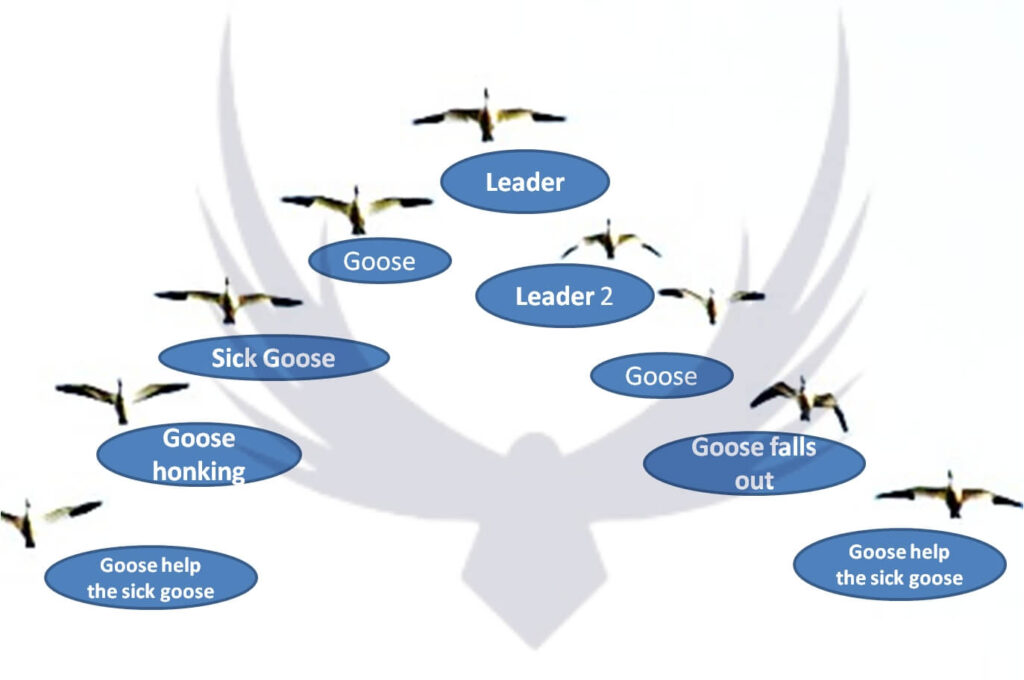
Good leadership means taking charge, making smart choices, and motivating others to cooperate towards a shared goal, just like the lead goose leads the flock during their long flights.
Establishing Leadership
In a group of geese, leadership is not a fixed or permanent role, but it changes based on different factors. Usually, the strongest, most experienced and physically fit goose take the lead to navigate and endure the challenges of migration during migration.
Geese can become leaders by being assertive, making sounds, or showing they are good at making decisions. This flexible leadership helps the group adjust to new situations and lets the most capable goose lead when needed.
Leading Effectively
Good leadership means making smart decisions based on the environment, communicating clearly with the flock, and motivating others to follow. The lead goose also takes turns with other birds to share the work and prevent exhaustion, showing the value of teamwork in leadership.
The lead goose in the V formation is important for a successful migration. It leads the flock by navigating changing winds, spotting obstacles, and adjusting the flight path.
Future Proof Leadership
The geese’s migration patterns and leadership roles are passed down from generation to generation, ensuring the continuity and adaptation of their behaviors.
Young geese learn migration patterns, flight formations, and leadership skills and principles by observing and following more experienced members of the flock. This mentoring process helps the young geese to stay strong and able to lead and adjust to new environments or migration paths.
Why is One Side Longer When Geese Fly in V Formation?
The V formation of geese often appears lopsided or J-shaped, with one side of the V being longer than the other. There are a couple of reasons why this asymmetrical formation occurs:
Wind Conditions
The J-shaped formation of geese is mainly because of the wind direction. Geese mostly fly in the V-shape to take maximum advantage of the wind’s lift and updrafts. The longer side of the J faces the wind to catch the updrafts from the birds in front. The shorter side is angled away from the wind.
Turbulence Effects
Geese on the outside of a V formation feel more wind turbulence than those on the inside. By making one side of the V longer, more birds can stay in the best updraft spots behind the leading birds’ wingtips, while fewer are exposed to too much turbulence.
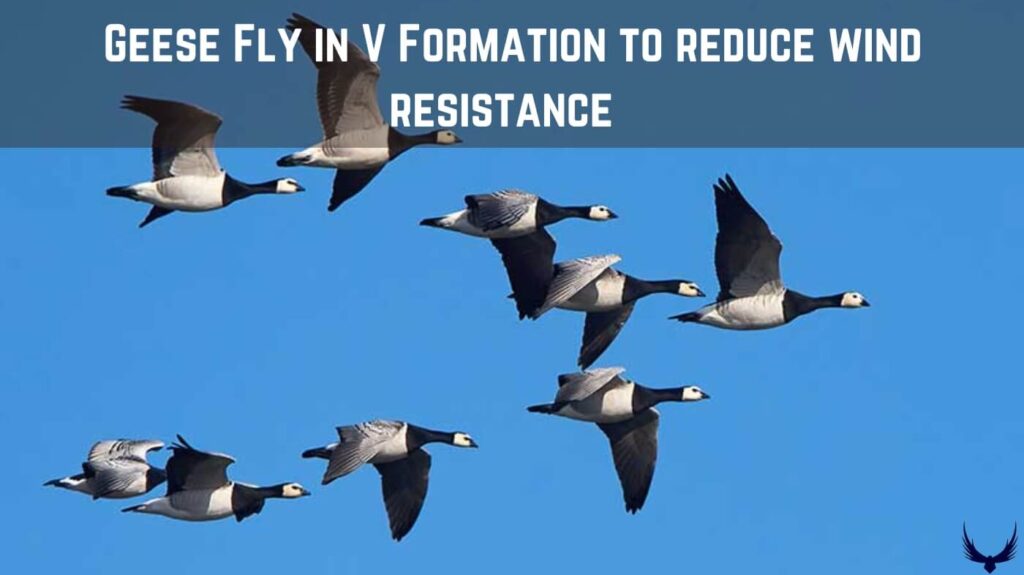
Visual Communication
Visual communication is improved with the J-shape formation because it allows more birds to see each other. The longer line at the front helps more geese to keep the lead goose and others in view for better coordination.
Rank Order
Some researchers think that the way birds fly in a J-shape might show their social rank in the flock. The geese that are more dominant tend to be in the best positions at the front of the group where the wind hits them first.
Other Birds That Fly in V Shape Formation
Many species of migratory birds fly in a V-shaped formation during their long journeys. This aerodynamic formation helps conserve energy by reducing air resistance and increases their chances of survival during long journeys.
While the V formation is most famously associated with geese, some other common birds that fly in V formations include:
- Pelicans
- Ibises
- Storks
- Cranes
- Swans
- Certain ducks like Shovelers
FAQs – Why do Geese Fly in a V formation?
What do Canadian Geese Eat?
Canadian geese eat plants like aquatic plants, grasses, grains, berries, and seeds. Sometimes they also eat small insects or crustaceans.
Why do Geese Honk When They Fly?
Geese honk to communicate and stay in V formation, to navigate and stay close to the group, to alert others of danger, and to announce their arrival or departure while flying.

